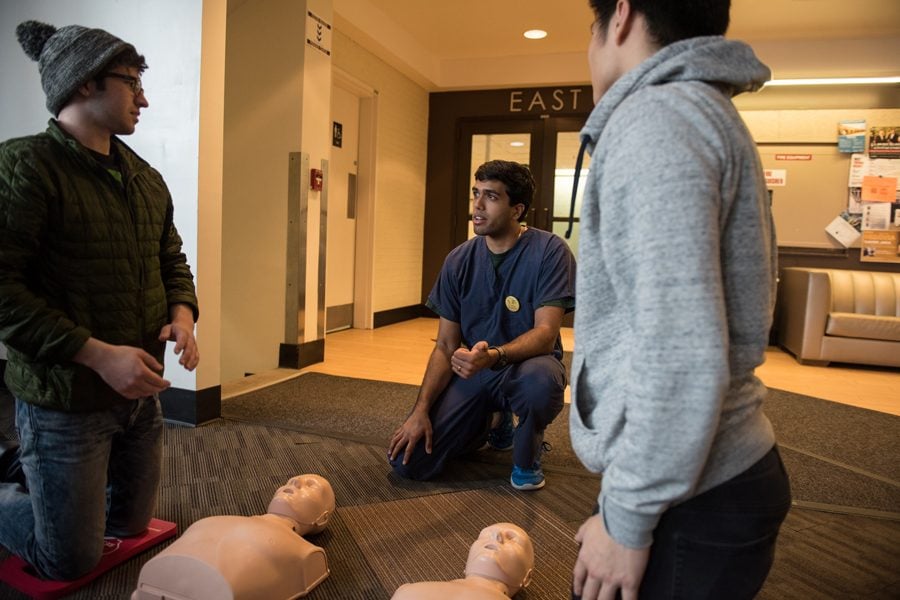NU joins national effort to train 10,000 in bystander CPR
Katie Pach/Daily Senior Staffer
Texas medical student Shyam Murali teaches Texas Two Step CPR to passersby in Foster-Walker Complex. The training event was part of a national effort to increase knowledge of bystander intervention technique.
February 25, 2018
Forty people were trained in CPR at Northwestern on Friday as part of a nationwide initiative to train 10,000 people in a single weekend.
The training took place at Foster-Walker Complex from 11 a.m. to 4 p.m., with several student volunteers and Texas medical student Shyam Murali training passersby using CPR mannequins.
The event was part of Texas Two Step CPR, an annual effort founded in 2015 by a group of medical students in Texas to spread a simple, hands-only CPR technique to the public. Instead of formal CPR certification, which can take around three hours, the initiative concentrates on simple, five-minute bystander intervention. Weinberg junior Anne Krall, who brought the event to NU, said NU is one of just two undergraduate institutions participating in the initiative.
Krall said Texas Two Step CPR is based on the idea that spreading a small amount of knowledge and training can decrease the number of cardiac-related fatalities nationwide.
“Having the ability to know what to do in an emergency is so powerful,” Krall said. “I don’t know any way to put it so plainly than that every single person can save someone’s life without any training beyond these five minutes.”
Krall said she first got involved with the initiative through her work with Illinois Heart Rescue — an effort to improve cardiac health statewide — where she was put in touch with Murali, who is on the board of directors for Texas Two Step CPR. Murali said the program left Texas and went national for the first time this year, adding medical student-run stations in six additional states.
Murali, who came to NU on Friday to assist with the CPR training, said the goal of the program is to teach CPR to as many people as possible. This CPR method consists of two simple steps: The first is to call 911 and the second is to provide chest compressions until help arrives. This method eliminates mouth-to-mouth breaths, a decision Murali said was made for maximum effectiveness.
“In the literature and science, (the compression part) has been shown to do the most amount of good,” he said. “The breaths aren’t as effective anymore, and the most important thing is to make sure the blood is flowing to the heart and the brain.”
Murali said the project is driven by medical students nationwide, and that other stations across the country will be set up in schools and public places including malls and parks. Murali said the organization hopes to expand the program next year to more cities and increase the number of student volunteers involved.
This year, more than 7,500 people were trained nationwide, with at least 1,200 in Chicago alone, Krall told The Daily on Sunday.
At NU, with Krall’s help, some undergraduate students got involved as volunteer trainers. Kate Sprengel, one of NU’s student volunteers, said the project was important because of the difference timely bystander intervention can make in emergency situations.
“It takes up to 10 or 20 minutes for EMTs to arrive usually, so if anyone has low blood flow your brain only has a couple of minutes before it’s gone forever,” the Weinberg junior said. “Bystander intervention literally saves people’s lives.”
Email: [email protected]
Twitter: @keerti_gopal


